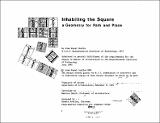| dc.contributor.advisor | Maurice Smith. | en_US |
| dc.contributor.author | Joslin, Alan Royal | en_US |
| dc.contributor.other | Massachusetts Institute of Technology. Dept. of Architecture. | en_US |
| dc.date.accessioned | 2012-11-19T19:03:47Z | |
| dc.date.available | 2012-11-19T19:03:47Z | |
| dc.date.copyright | 1982 | en_US |
| dc.date.issued | 1982 | en_US |
| dc.identifier.uri | http://hdl.handle.net/1721.1/74743 | |
| dc.description | Thesis (M. Arch.)--Massachusetts Institute of Technology, Dept. of Architecture, 1982. | en_US |
| dc.description | MICROFICHE COPY AVAILABLE IN ARCHIVES AND ROTCH. | en_US |
| dc.description | Includes bibliographical references. | en_US |
| dc.description.abstract | Geometries and geometric systems are not architecture, though architecture is geometric. Geometries and geometric systems, because of their autonomous nature, are generally understandable and can serve as the basis of communicable patterns expressed in architectural form, even though they are not necessarily at the base of man's structural understanding of environmental order. As a method of illustration, this study focuses on the geometry of the square, realizing its persistent and valued use in architectural works of all peoples, in all cultures, throughout all of history. The square is considered as the basic geometric unit which generates the cube, the grid, and the frame. The square and its derivatives are examined with regard to their inherent quantitative, qualitative, and structural properties. The square/orthogonal organization is compared both to concentric and to topological organizations and is shown to have special value as a structure for man's physical/architectural environment. The observance of orthogonal and concentric organizations as experiential phenomena in nature is found to have a major influence on the meanings and symbolic significance which these systems have historically held. Some historical examples are shown to illustrate the functional and symbolic roles that the square/cube, circle/sphere, and grid/frame have played in the structuring of architectural space and form. Some architectural compositions within a square plan, by a number of modern and contemporary architects, are analyzed, focusing on: (1) the descriptive nature of the relationship between functional/formal organization and the geometric structure of the square, and (2) the value that the square holds in these architects' work. Finally, the square is shown to be the basis for two general systems of measure: (1) open grids, and (2) grids of symmetry. The character of these systems are illustrated through their appearance in the structuring of natural form. Historical examples are then presented to show these systems' use and value in architecture. | en_US |
| dc.description.statementofresponsibility | by Alan Royal Joslin. | en_US |
| dc.format.extent | viii, 166 p. | en_US |
| dc.language.iso | eng | en_US |
| dc.publisher | Massachusetts Institute of Technology | en_US |
| dc.rights | M.I.T. theses are protected by
copyright. They may be viewed from this source for any purpose, but
reproduction or distribution in any format is prohibited without written
permission. See provided URL for inquiries about permission. | en_US |
| dc.rights.uri | http://dspace.mit.edu/handle/1721.1/7582 | en_US |
| dc.subject | Architecture. | en_US |
| dc.subject.lcsh | Square | en_US |
| dc.subject.lcsh | Architectural design | en_US |
| dc.title | Inhabiting the square; a geometry for path and space | en_US |
| dc.type | Thesis | en_US |
| dc.description.degree | M.Arch. | en_US |
| dc.contributor.department | Massachusetts Institute of Technology. Department of Architecture | |
| dc.identifier.oclc | 09038812 | en_US |
